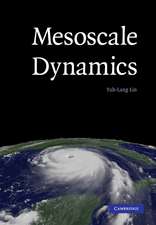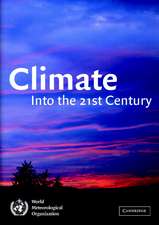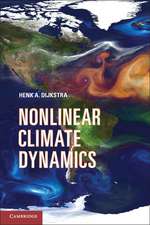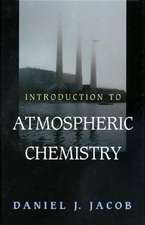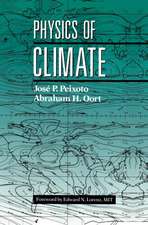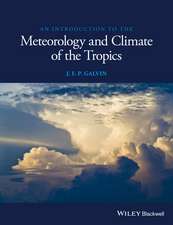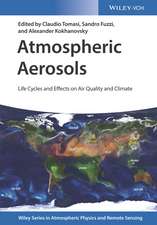Atmospheric Tidal and Planetary Waves: Atmospheric and Oceanographic Sciences Library, cartea 12
Autor Hans Vollanden Limba Engleză Hardback – 31 oct 1988
| Toate formatele și edițiile | Preț | Express |
|---|---|---|
| Paperback (1) | 1210.93 lei 6-8 săpt. | |
| SPRINGER NETHERLANDS – 6 oct 2011 | 1210.93 lei 6-8 săpt. | |
| Hardback (1) | 1217.84 lei 6-8 săpt. | |
| SPRINGER NETHERLANDS – 31 oct 1988 | 1217.84 lei 6-8 săpt. |
Din seria Atmospheric and Oceanographic Sciences Library
- 18%
 Preț: 2095.67 lei
Preț: 2095.67 lei - 18%
 Preț: 950.69 lei
Preț: 950.69 lei - 18%
 Preț: 956.05 lei
Preț: 956.05 lei - 18%
 Preț: 1148.09 lei
Preț: 1148.09 lei - 18%
 Preț: 941.62 lei
Preț: 941.62 lei - 18%
 Preț: 939.58 lei
Preț: 939.58 lei - 18%
 Preț: 1215.15 lei
Preț: 1215.15 lei - 18%
 Preț: 945.25 lei
Preț: 945.25 lei - 15%
 Preț: 635.20 lei
Preț: 635.20 lei - 18%
 Preț: 1220.51 lei
Preț: 1220.51 lei - 18%
 Preț: 1408.49 lei
Preț: 1408.49 lei - 18%
 Preț: 943.66 lei
Preț: 943.66 lei - 24%
 Preț: 801.38 lei
Preț: 801.38 lei - 18%
 Preț: 1228.17 lei
Preț: 1228.17 lei - 18%
 Preț: 1216.75 lei
Preț: 1216.75 lei - 18%
 Preț: 953.36 lei
Preț: 953.36 lei - 18%
 Preț: 1382.18 lei
Preț: 1382.18 lei - 18%
 Preț: 940.19 lei
Preț: 940.19 lei - 18%
 Preț: 1226.61 lei
Preț: 1226.61 lei - 18%
 Preț: 1535.44 lei
Preț: 1535.44 lei - 18%
 Preț: 1380.31 lei
Preț: 1380.31 lei - 18%
 Preț: 1217.67 lei
Preț: 1217.67 lei - 18%
 Preț: 967.49 lei
Preț: 967.49 lei - 18%
 Preț: 945.38 lei
Preț: 945.38 lei - 18%
 Preț: 947.42 lei
Preț: 947.42 lei -
 Preț: 387.40 lei
Preț: 387.40 lei - 20%
 Preț: 585.97 lei
Preț: 585.97 lei
Preț: 1217.84 lei
Preț vechi: 1485.17 lei
-18% Nou
Puncte Express: 1827
Preț estimativ în valută:
233.24€ • 240.30$ • 195.38£
233.24€ • 240.30$ • 195.38£
Carte tipărită la comandă
Livrare economică 24 februarie-10 martie
Preluare comenzi: 021 569.72.76
Specificații
ISBN-13: 9789027726308
ISBN-10: 9027726302
Pagini: 362
Ilustrații: X, 348 p.
Dimensiuni: 156 x 234 x 25 mm
Greutate: 0.71 kg
Ediția:1988
Editura: SPRINGER NETHERLANDS
Colecția Springer
Seria Atmospheric and Oceanographic Sciences Library
Locul publicării:Dordrecht, Netherlands
ISBN-10: 9027726302
Pagini: 362
Ilustrații: X, 348 p.
Dimensiuni: 156 x 234 x 25 mm
Greutate: 0.71 kg
Ediția:1988
Editura: SPRINGER NETHERLANDS
Colecția Springer
Seria Atmospheric and Oceanographic Sciences Library
Locul publicării:Dordrecht, Netherlands
Public țintă
ResearchCuprins
1. Introduction.- 2. Basic Equations.- 2.1. Hydrodynamic and Thermodynamic Equations.- 2.2. Equations of the Mean Flow.- 2.3. Equations of the Eddies.- 2.4. Energy Balance.- 2.5. Vorticity and Divergence.- 2.6. Linearization.- 2.7. Eliassen-Palm Flux.- 2.8. Ertel Potential Vorticity.- 2.9. Diffusive Separation of Atmospheric Constituents.- 2.10. Spherical Harmonics.- 2.11. Hermite Functions.- 3. External Energy Sources.- 3.1. Solar Irradiance.- 3.2. Solar Heat Input into Upper Atmosphere.- 3.3. Solar Heat Input into Lower and Middle Atmosphere.- 3.4. Lunar Gravitational Tidal Energy.- 3.5. Solar Wind Energy.- 4. Internal Energy Sources and Sinks.- 4.1. Eddy Viscosity.- 4.2. Eddy Heat Conduction.- 4.3. Latent Heat.- 4.4. Newtonian Cooling.- 4.5. Rayleigh Friction.- 4.6. Ion Drag.- 4.7. Feedback between Large-Scale Eddies and Mean Flow.- 5. Horizontal Modal Structure.- 5.1. Separation of Variables.- 5.2. Eigenvalues of Laplace’s Equations.- 5.3. Gravity Waves.- 5.4. Rossby-Haurwitz Waves.- 5.5. Kelvin Waves and Yanai Waves.- 5.6. Low Frequency Waves with Positive Eigenvalues.- 5.7. Class II Waves of Wavenumber m = 0.- 5.8. Diurnal Tides.- 5.9. Dynamo Action of Tidal Winds.- 5.10. Rossby Waves Migrating within Mean Zonal Flow.- 5.11. Influence of Zonal Mean Flow on Rossby-Haurwitz Waves.- 5.12. Solutions of Inhomogeneous Laplace Equations.- 6. Vertical Modal Structure.- 6.1. Characteristic Waves.- 6.2. Vertical Wavenumber.- 6.3. Particular Solutions.- 6.4. Boundary Conditions.- 6.5. Normal Modes.- 6.6. Height Structure of External Waves.- 6.7. Directly Driven Circulation Cells.- 6.8. Indirectly Driven Circulation Cells.- 6.9. Height Structure of Internal Waves.- 6.10. Impulsive Heat Input.- 6.11. Ray Tracing of Rossby Waves.- 6.12. Mode Conversion.- 6.13. BaroclinicInstability.- 7. Nonlinear Wave Propagation.- 7.1. Nonlinear Coupling between Rossby-Haurwitz Waves.- 7.2. Analytic Solutions for Weak Coupling of Rossby-Haurwitz Waves.- 7.3. Rossby-Haurwitz Wave Coupling in Realistic Mean Flow.- 7.4. Homogeneous and Isotropic Turbulence.- 7.5. Space-Time Analysis.- 7.6. Nonlinear Normal Mode Initialization.- 7.7. Lorenz Attractor.- 7.8. Logistic Difference Equation.- 7.9. Multiple Equilibria.- 8. Tidal Waves.- 8.1. Seasonal Tides within Lower and Middle Atmosphere (m = 0).- 8.2. Quasi-Stationary Seasonal Waves (m > 0).- 8.3. Climatic Mean Flow.- 8.4. Seasonal Tides within Upper Atmosphere.- 8.5. Migrating Solar Diurnal Tides within Lower and Middle Atmosphere.- 8.6. Migrating Solar Diurnal Tides within Upper Atmosphere.- 8.7. Nonmigrating Solar Diurnal Tides.- 8.8. Lunar Tides.- 8.9. Electromagnetic Effects of Tidal Waves.- 8.10. Energy and Momentum Deposition of Solar Diurnal Tides.- 9. Planetary Waves.- 9.1. Extratropical Transients.- 9.2. Southern Oscillation.- 9.3. Forty-Day Oscillations.- 9.4. Transients in the Tropical Middle Atmosphere.- 9.5. Fluctuations of Atmospheric Angular Momentum.- 9.6. Sudden Stratospheric Warmings.- 9.7. Thermospheric Response to Solar EUV Fluctuations.- 9.8. Thermospheric Storms.- 9.9. Solar Activity Effects within Middle and Lower Atmosphere.- 10. Epilogue.- References.
Recenzii
`It can be highly recommended for advanced students and workers in meteorology, geophysics, space physics, fluid mechanics and applied mathematics.'
Contributions to Atmospheric Physics/Beiträge zur Physik der Atmosphäre, 63 (3,4)
Contributions to Atmospheric Physics/Beiträge zur Physik der Atmosphäre, 63 (3,4)
Caracteristici
Includes supplementary material: sn.pub/extras

